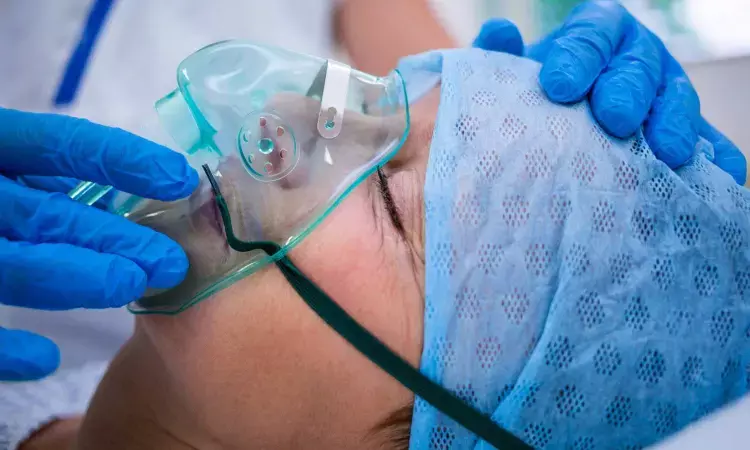- Home
- Medical news & Guidelines
- Anesthesiology
- Cardiology and CTVS
- Critical Care
- Dentistry
- Dermatology
- Diabetes and Endocrinology
- ENT
- Gastroenterology
- Medicine
- Nephrology
- Neurology
- Obstretics-Gynaecology
- Oncology
- Ophthalmology
- Orthopaedics
- Pediatrics-Neonatology
- Psychiatry
- Pulmonology
- Radiology
- Surgery
- Urology
- Laboratory Medicine
- Diet
- Nursing
- Paramedical
- Physiotherapy
- Health news
- Fact Check
- Bone Health Fact Check
- Brain Health Fact Check
- Cancer Related Fact Check
- Child Care Fact Check
- Dental and oral health fact check
- Diabetes and metabolic health fact check
- Diet and Nutrition Fact Check
- Eye and ENT Care Fact Check
- Fitness fact check
- Gut health fact check
- Heart health fact check
- Kidney health fact check
- Medical education fact check
- Men's health fact check
- Respiratory fact check
- Skin and hair care fact check
- Vaccine and Immunization fact check
- Women's health fact check
- AYUSH
- State News
- Andaman and Nicobar Islands
- Andhra Pradesh
- Arunachal Pradesh
- Assam
- Bihar
- Chandigarh
- Chattisgarh
- Dadra and Nagar Haveli
- Daman and Diu
- Delhi
- Goa
- Gujarat
- Haryana
- Himachal Pradesh
- Jammu & Kashmir
- Jharkhand
- Karnataka
- Kerala
- Ladakh
- Lakshadweep
- Madhya Pradesh
- Maharashtra
- Manipur
- Meghalaya
- Mizoram
- Nagaland
- Odisha
- Puducherry
- Punjab
- Rajasthan
- Sikkim
- Tamil Nadu
- Telangana
- Tripura
- Uttar Pradesh
- Uttrakhand
- West Bengal
- Medical Education
- Industry
Higher-dose corticosteroids raise mortality risk by 60 percent in low-oxygen COVID patients: Lancet

UK: Higher dose corticosteroids compared with standard dose corticosteroids increase mortality for patients with COVID-19 and hypoxia who are not receiving invasive or non-invasive mechanical ventilation, findings from a large, randomised trial have shown.
The study found that compared with standard care that included low-dose corticosteroid use, treating hypoxic COVID-19 patients needing only oxygen therapy or no breathing support with higher dose corticosteroids is associated with a 60% increased risk of death.
The study will be presented at the 2023 European Congress of Clinical Microbiology & Infectious Diseases (ECCMID 2023, Copenhagen 15-18 April) and published in The Lancet.
This study conducted by the RECOVERY Collaborative Group and led by Prof Sir Peter Horby and Prof Sir Martin Landray (both of the University of Oxford, UK) had already identified that low-dose corticosteroids reduce patient mortality with COVID-19 requiring oxygen or ventilatory support. Since May 2021, the RECOVERY trial has evaluated the use of a higher dose of corticosteroids in this patient group. However, in May 2022, the independent Data Monitoring Committee advised that this treatment assessment be stopped for those patients receiving oxygen alone or no breathing support. The trial continues to study the effects of high-dose corticosteroids for those needing non-invasive or invasive mechanical ventilation.
Eligible and consenting adult patients with COVID-19 and clinical evidence of hypoxia (ie, receiving oxygen or with oxygen saturation <92% in normal room air) were randomly allocated (1:1) to either usual care with higher dose corticosteroids (dexamethasone 20 mg once daily for 5 days followed by 10 mg dexamethasone once daily for five days or until discharge if sooner) or usual standard of care alone (which included dexamethasone at the lower 6 mg once daily dose for ten days or until discharge if sooner). The primary outcome was 28-day mortality among all randomised participants.
Between May 25, 2021, and May 13, 2022, 1272 patients with COVID-19 and hypoxia receiving no oxygen (eight [1%]) or simple oxygen only (1264 [99%]) were randomly allocated to receive usual care plus higher dose corticosteroids (659 patients) versus usual care alone (613 patients, of whom 87% received low-dose corticosteroids during the follow-up period). Of those randomly assigned, 745 (59%) were in Asia, 512 (40%) in the UK, and 15 (1%) in Africa. 248 (19%) had diabetes, and 769 (60%) were male. Overall, 123 (19%) of 659 patients allocated to higher dose corticosteroids versus 75 (12%) of 613 patients allocated to usual care died within 28 days – meaning a 60% increased mortality risk for the higher dose corticosteroid group.
There was also an excess of pneumonia reported to be due to non-COVID infection in the higher-dose corticosteroid group: 64 cases (10%) vs 37 cases (6%); and an increase in hyperglycaemia (high blood sugar episode) requiring an increased insulin dose: 142 [22%] vs 87 [14%].
The authors conclude: “Among hospitalised patients with COVID-19 who require oxygen or ventilatory support, low-dose corticosteroids reduce the risk of death. However, among patients requiring simple oxygen, higher doses of corticosteroids increase the risk of death compared with low-dose corticosteroids. It remains unclear whether using a higher dose of corticosteroids is beneficial among patients requiring non-invasive or invasive ventilation—the RECOVERY trial continues to study this.”
Reference:
The Lancet; European Congress of Clinical Microbiology & Infectious Diseases (ECCMID) 2023.
Dr Kamal Kant Kohli-MBBS, DTCD- a chest specialist with more than 30 years of practice and a flair for writing clinical articles, Dr Kamal Kant Kohli joined Medical Dialogues as a Chief Editor of Medical News. Besides writing articles, as an editor, he proofreads and verifies all the medical content published on Medical Dialogues including those coming from journals, studies,medical conferences,guidelines etc. Email: drkohli@medicaldialogues.in. Contact no. 011-43720751


